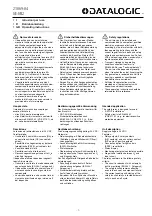
protect for overexcitation resulting from an
erroneous voltage indication if the 24 relay is
connected to an ac potential source different
than that used for the regulator.
Fig. 23 shows the relation among the Basler
BE1-GPS100, BE1-951, BE1051, and BE1-24
relay inverse squared characteristics and an
example of a generator and transformer with-
stand capability. The generator and transformer
manufacturers should supply the specific
capabilities of these units.
FIGURE 23. COMBINED GENERATOR/TRANSFORMER
OVEREXCITATION PROTECTION USING BOTH THE
INVERSE SQUARED TRIPPING. EQUIPMENT
WITHSTAND CURVES ARE EXAMPLES ONLY.
Phase over (59) and under (27) voltage relaying
also acts as a backup for excitation system
problems. Undervoltage relaying also acts as
fault detection relaying, because faults tend to
depress voltage.
Off-Frequency Operation
Diesel engines can be safely operated off normal
frequency, and minimal protection is required.
Turbine controls generally provide protection for
off frequency conditions, but relaying should be
provided to protect the turbine and generator
during control system failure. Frequency relays
are frequently applied with steam-turbine units,
particularly to minimize turbine blade fatiguing.
IEEE C37.106, Ref. 3 specifically addresses
abnormal frequency operation and shows typical
frequency operating limits specified by various
generator manufacturers. The simplest relay
application would be a single underfrequency
stage, but a multiple stage and multiple set point
arrangement may be advantageous. Each set
point may be set to recognize either over-
frequency or underfrequency. Multiple frequency
set points are available in the BE1-81O/U, BE1-
GPS100, BE1-951, and BE1-1051.
Another common need for frequency relaying is
the detection of generation that has become
isolated from the larger utility system grid. When
a generator is connected to the utility, generator
frequency is held tightly to system frequency.
Upon islanding, the generator frequency varies
considerably as the governor works to adjust
generator power output to local load. If the
generator frequency varies from nominal,
islanding is declared and either the generator is
tripped or the point of common coupling with the
utility is opened.
Inadvertent Energization Protection
Inadvertent energization can result from a
breaker interrupter flashover or a breaker close
initiation while the unit is at standstill or at low
speed. The rapid acceleration can do extensive
damage, particularly if the generator is not
promptly de-energized. While relays applied for
other purposes may eventually respond, they are
not generally considered dependable for respond-
ing to such an energization.
Figs. 24 and 25 show two methods of detecting
the energization of a machine at standstill or at a
speed significantly lower than rated. This could
be caused by single-phase energization due to
breaker-interrupter flashover or 3 phase
energization due to breaker closure. The unit,
without excitation, will accelerate as an
induction motor with excessive current flow in
the rotor. Both Fig. 24 and 25 schemes will
function properly with the VT fuses at the
generator terminal removed. With the generator
off line, safety requirements may dictate the
removal of these VT fuses. In the case of Fig.
13
Содержание BE1-1051
Страница 1: ...GeneratorProtection ApplicationGuide...








































